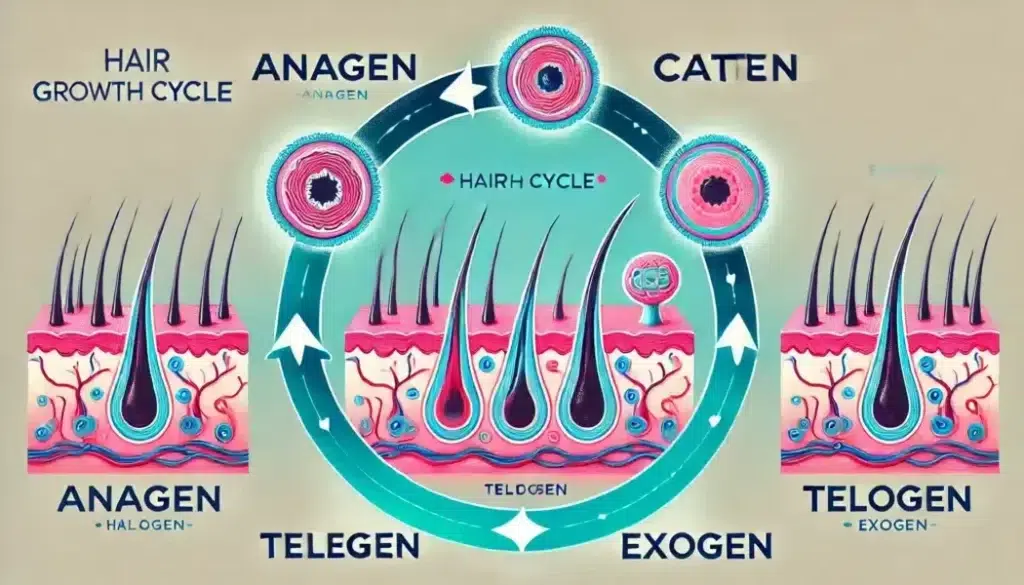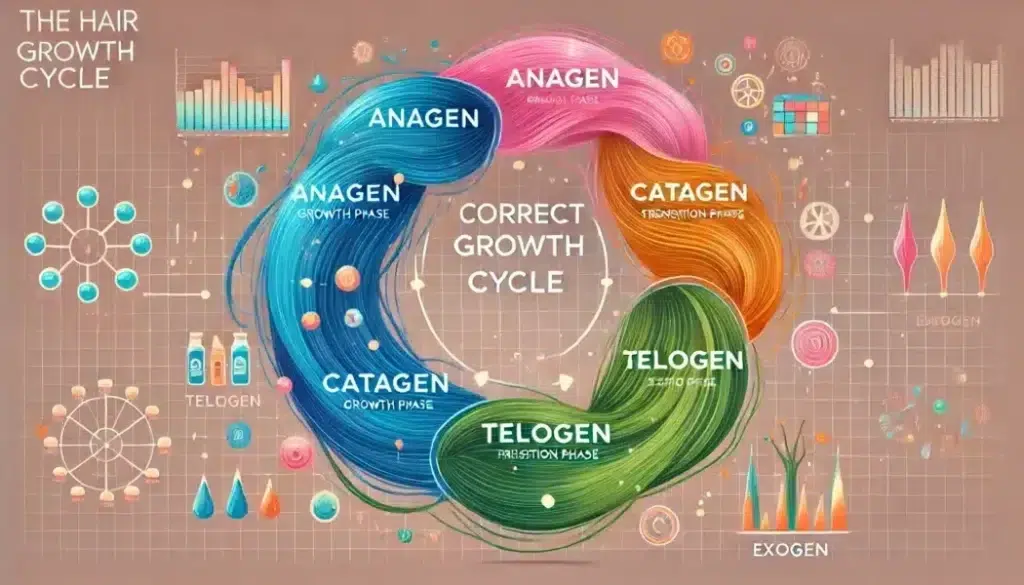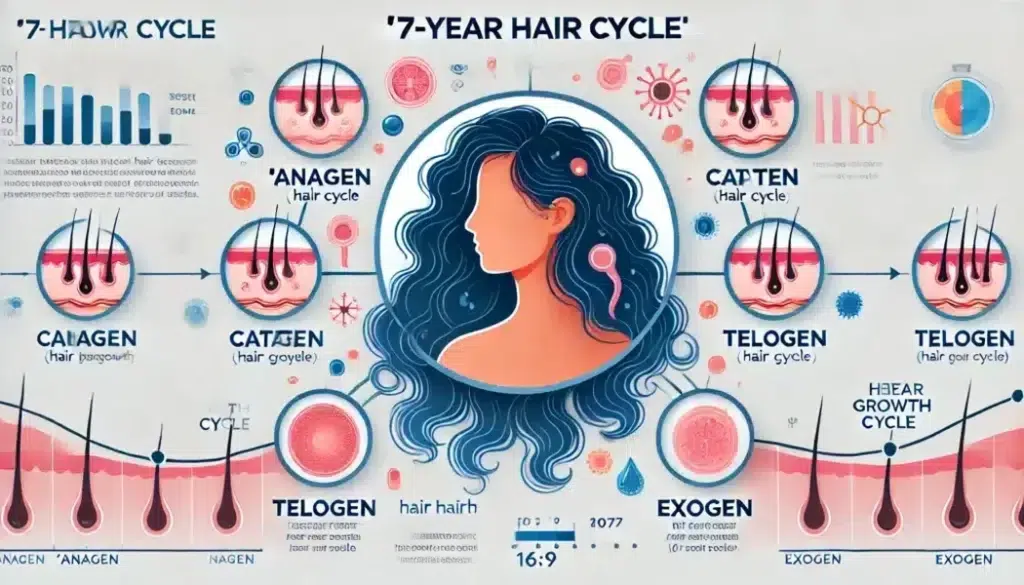Getting a handle on how your hair works means knowing the basics of hair growth cycles. It’s kind of like understanding the four seasons but for your hair.
Knowing the ins and outs of hair growth is super helpful. You can figure out why your hair does what it does, and maybe even tackle some hair issues at the root (pun intended).
Let’s start with some quick anatomy. Each hair on your head grows from a tiny pocket in your skin called a follicle. These follicles are responsible for producing the hair strand and have their own life cycle.

Speaking of cycles, hair growth happens in different stages. There are four main ones: Anagen, Catagen, Telogen, and Exogen. Each has its own job and timeframe.
In the Anagen phase, hair is actively growing. This can last anywhere from 2-7 years depending on genetics and other factors.
Next up is Catagen, a short transitional phase that lasts about 10 days. The hair stops growing and detaches from the follicle.
Then there’s Telogen, the resting phase. Here, the hair doesn’t grow but stays attached. This stage lasts around 3 months.
Finally, Exogen is when the hair actually falls out. Don’t worry, it’s making room for new growth.
Understanding these stages can give you a clearer picture of what’s happening with your hair on a day-to-day basis. It can also help you make informed decisions about hair care and products.
📊 Understanding the Correct Hair Growth Cycle
What’s the correct hair growth cycle, you ask? It’s all about those four stages we touched on earlier. Each stage has a distinct role to play in keeping your hair growing and healthy.
First is Anagen, the growth phase. Here, your hair is actively growing, getting longer and stronger. This phase can last anywhere from a couple of years to as long as seven years, largely thanks to your genetics. It’s the phase to capitalize on if you’re looking to grow out your locks.
Following Anagen is Catagen. Think of this as a short transition period, lasting about 10 days. The hair follicle renews itself, and the strand begins to detach. It’s like a prep phase for the next stage.
Next is Telogen, the resting phase. During this phase, hair isn’t actively growing but stays rooted in place. It’s essentially a maintenance stage that lasts about three months.
Finally, we’ve got Exogen, where the hair strand falls out. This is a natural process making way for new growth, so don’t be alarmed when you see a few strands in the shower

Factors like diet, lifestyle, and hair care routines can influence how long each of these phases lasts. For example, stress or poor nutrition might shorten the Anagen phase, meaning less time for your hair to grow. On the flip side, good care can keep your hair in the growth phase longer.
Knowing these phases helps you understand why certain hair treatments or routines work better at specific times. For example, scalp massages are great for the Anagen phase, while minimizing stress can be beneficial throughout all stages. It’s all interconnected.
🔍 Identifying Your Hair Growth Pattern
Figuring out your hair growth pattern can feel like cracking a secret code, but it’s easier than you might think. This is all about observing and understanding what’s happening on your own scalp.
Start by taking a close look at your shedding patterns. How much hair do you lose daily? Losing 50-100 strands a day is totally normal and part of the Exogen phase. If you’re losing way more, it’s worth keeping an eye on.
Next, consider the length your hair typically reaches before you feel the need for a trim. If your hair doesn’t seem to grow past a certain length, you might be experiencing a shorter Anagen phase. This is a genetic trait and pretty common.
Pay attention to texture changes too. Notice if your hair becomes finer or more brittle; this could indicate a shift in your growth pattern or even a phase transition.

Don’t overlook the impact of lifestyle factors. Stress, diet, and even sleep can play huge roles in your hair’s behavior. A balanced diet and regular exercise can promote a healthier Anagen phase, resulting in longer hair growth.
Using tools like a hair growth tracker or even apps can help you notice patterns over time. Keeping a hair journal where you jot down your hair care routine, dietary changes, and stress levels can provide insight into any shifts in your hair growth cycles.
Consulting a dermatologist or a trichologist if you’re really puzzled can be immensely helpful. These professionals can offer personalized insights and even run tests to pinpoint specific growth issues.
By becoming more in tune with your hair’s natural rhythm, you can make more informed decisions about hair care products and routines that suit your unique pattern.
🧯 Debunking the Myth: The 7-Year Hair Cycle
Ever hear about the so-called ‘7-year hair cycle’? It’s one of those hair myths that seem to stick around. Spoiler alert: it’s not entirely accurate.
The idea behind the 7-year hair cycle is that every single strand of hair on your head undergoes a complete life cycle every seven years. While it’s true that hair has a life cycle, pinning it down to seven years doesn’t hold up under scientific scrutiny.
What actually happens is that each hair follicle is on its own unique cycle. This individual cycle doesn’t sync up with a universal 7-year timeline. Each strand of hair can be in different phases—Anagen, Catagen, Telogen, or Exogen—at any given time.

The origins of this myth can probably be traced back to general estimates for hair growth duration but have since been disproven by more precise scientific studies. In reality, most people’s hair growth cycles vary significantly, influenced by genetics, health, and even seasonal changes.
Understanding the real timelines can help you set more accurate expectations for your hair goals. Instead of aiming for a 7-year cycle, focus on maintaining healthy hair practices and adjusting based on what your hair is telling you. Using good-quality hair products, eating a balanced diet, and avoiding excessive stress can help keep your hair in good condition across its varying phases.
By learning how your hair naturally grows, you’re one step closer to making smarter choices for stronger, healthier strands.
If you’re curious about how hormones, stress, or nutrition might be influencing your cycle, feel free to explore the related guides below.
Your hair has a rhythm — now it’s time to dance in tune with it.
So next time someone mentions the 7-year hair cycle, you can smile, nod, and politely set the record straight. It’s all about understanding your unique hair growth pattern and giving your hair what it needs when it needs it.
Stay with us — the best is yet to come.
By following our advice, you’re doing the most you can for your hair.
Be the first to know when we publish new guides, tests, and proven strategies for stronger, healthier hair.
👉 Visit the About Me page to learn more about my journey, mission, and why helping people with hair health is so personal to me.
Want healthier, stronger hair? Discover 8 science-backed habits that protect your scalp and boost natural growth. Get your free PDF guide today!
Disclaimer: This article is for informational purposes only and is not a substitute for professional medical advice. Sensitive claims are supported with scientific references, and full product details can always be found on the official websites of the respective manufacturers or distributors.
Some links in this article are affiliate links. If you choose to make a purchase through them, I may earn a small commission at no extra cost to you — helping me keep HairGrowGenius running. Thank you for your support!

✅ FAQ Section – For Post: Understanding Hair Growth Cycles
❓Why does hair seem to grow faster in the summer than in winter?
During summer months, higher temperatures and increased blood circulation can stimulate follicle activity, leading to slightly faster hair growth. Hormonal rhythms may also play a role in seasonal changes. However, the difference is minimal—usually just a few extra millimeters per month.
❓Is it normal to lose over 100 hairs per day?
Yes, it’s considered normal to shed between 50 to 100 hairs a day during the exogen (shedding) phase. The number can vary depending on factors like brushing, washing, or stress. If the hair loss consistently exceeds 100 strands per day for several weeks, it may be worth consulting a dermatologist or trichologist.
❓Can hair follicles become permanently inactive?
Hair follicles can enter prolonged resting (telogen) or miniaturization phases due to genetics, hormonal changes, or aging. While they may appear dormant, many follicles can still respond to treatments like minoxidil or finasteride. True follicle death is rare unless caused by scarring conditions.
❓What is FGF5, and can it extend the hair growth phase?
FGF5 is a signaling protein that tells hair follicles to stop growing and enter the catagen phase. Inhibiting FGF5 has been shown in animal studies to prolong the anagen (growth) phase, resulting in longer hair. While human-targeted FGF5 treatments are under research, no clinically approved options exist yet.
Last updated: June 2025 based on latest research.


Leave a Reply